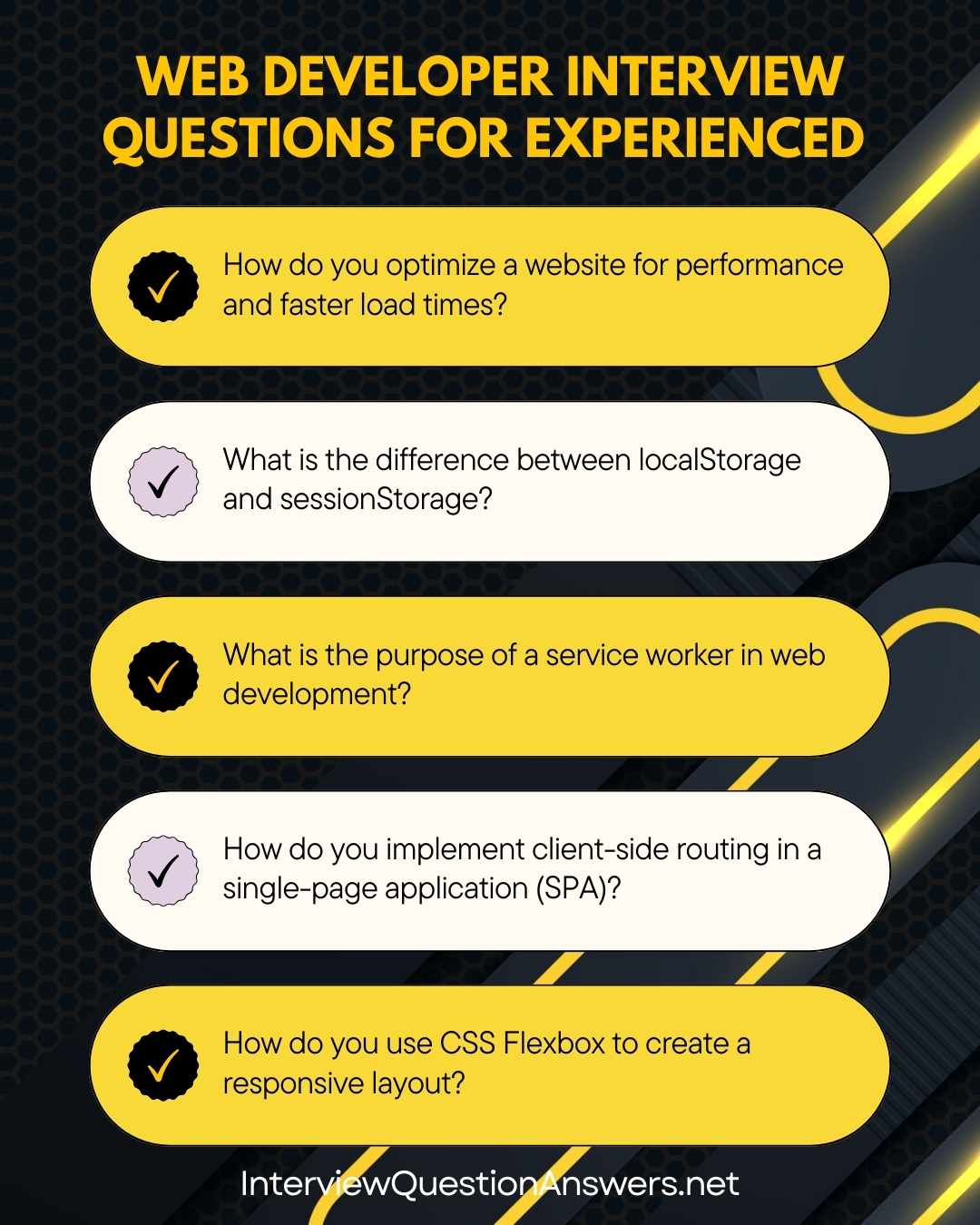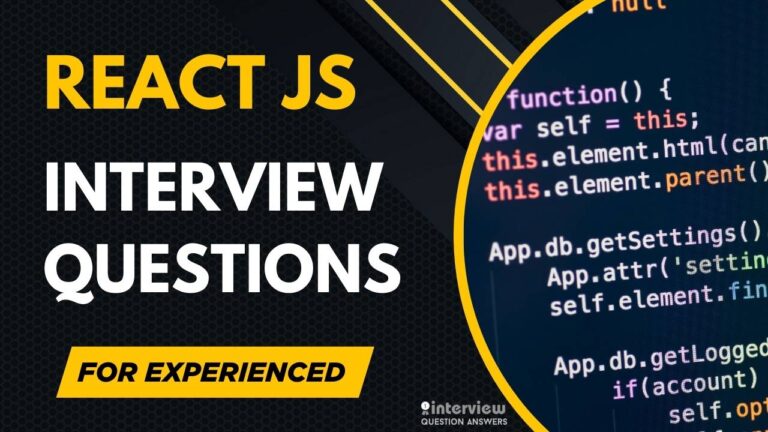Most Asked Web Developer Interview Questions for Experienced
Web Developer Interview Questions for Experienced professionals target advanced coding abilities, technical problem-solving skills, and leadership qualities that companies expect from senior developers. Senior web development roles require candidates to demonstrate how they handle complex projects and guide junior team members effectively.
This interview guide contains Web Development Interview Questions for Experienced developers who have created multiple websites and web applications, covering topics like advanced JavaScript techniques, responsive design strategies, web security practices, and client communication skills.
These Web Developer Interview Questions for Experienced candidates will help you showcase your technical knowledge, share real examples from your work experience, and prove you can manage challenging web development projects in professional settings.
Table of Contents
Web Developer Interview Questions for 2 Years Experience
Que 1. How do you optimize a website for performance and faster load times?
Answer:
Minify CSS/JavaScript, compress images, use lazy loading, enable browser caching with HTTP headers, and leverage CDNs. Use tools like Lighthouse to identify bottlenecks and optimize critical rendering paths.
<img src="image.jpg" loading="lazy" alt="Description">Que 2. What is the difference between localStorage and sessionStorage?
Answer:localStorage persists data until explicitly cleared, while sessionStorage lasts only for the session (until the browser tab closes). Both store key-value pairs.
localStorage.setItem('key', 'value');
sessionStorage.setItem('key', 'value');Que 3. How do you implement responsive design using CSS?
Answer:
Use relative units (rem, vw), media queries, and frameworks like Bootstrap. Ensure layouts adapt with Flexbox or Grid and test across devices.
.container {
display: grid;
grid-template-columns: repeat(auto-fit, minmax(200px, 1fr));
}
@media (max-width: 600px) {
.container { grid-template-columns: 1fr; }
}Que 4. How do you handle cross-browser compatibility issues?
Answer:
Use vendor prefixes, polyfills, and tools like Autoprefixer. Normalize styles with normalize.css and test with tools like BrowserStack.
/* normalize.css */
* { box-sizing: border-box; }Que 5. How do you make an HTTP request using the Fetch API?
Answer:
Use fetch with promises or async/await to make HTTP requests, handling responses and errors.
async function getData() {
try {
const response = await fetch('https://api.example.com/data');
const data = await response.json();
console.log(data);
} catch (error) {
console.error('Error:', error);
}
}Que 6. What is the purpose of a service worker in web development?
Answer:
Service workers enable offline functionality, caching, and push notifications for PWAs by intercepting network requests and managing cache.
// sw.js
self.addEventListener('install', event => {
event.waitUntil(caches.open('cache-v1').then(cache => cache.addAll(['index.html'])));
});Que 7. How do you secure a web application against XSS attacks?
Answer:
Sanitize user inputs, use Content Security Policy (CSP), escape dynamic content, and avoid innerHTML. Libraries like DOMPurify help ensure safe HTML.
<meta http-equiv="Content-Security-Policy" content="default-src 'self'">Que 8. How do you implement client-side routing in a single-page application (SPA)?
Answer:
Use the History API or a framework like React Router to manage routes without reloading, updating the UI based on URL changes.
function navigate(path) {
history.pushState({}, '', path);
renderPage(path);
}
window.addEventListener('popstate', () => renderPage(location.pathname));Que 9. How do you use CSS Flexbox to create a responsive layout?
Answer:
Use display: flex with properties like justify-content and align-items to create flexible, responsive layouts.
.container {
display: flex;
justify-content: space-between;
align-items: center;
flex-wrap: wrap;
}Que 10. How do you debug JavaScript code effectively?
Answer:
Use browser DevTools to set breakpoints, inspect variables, and monitor network activity. Log with console.log() or use tools like VS Code’s debugger.
console.log('Debug:', variable);
Also Check: Web Developer Interview Questions for Freshers
Web Developer Interview Questions for 3 Years Experience
Que 11. How do you implement form validation in JavaScript?
Answer:
Combine HTML5 validation attributes (required, pattern) with JavaScript to validate inputs and display errors dynamically.
const form = document.querySelector('form');
form.addEventListener('submit', e => {
const input = form.querySelector('input');
if (!input.value) {
e.preventDefault();
input.nextElementSibling.textContent = 'Required';
}
});<form>
<input type="text" required>
<span></span>
</form>Que 12. What is the purpose of Webpack in a web project?
Answer:
Webpack bundles JavaScript, CSS, and assets, optimizing with tree-shaking, minification, and code splitting for better performance.
// webpack.config.js
module.exports = {
entry: './src/index.js',
output: { filename: 'bundle.js' },
module: { rules: [{ test: /\.css$/, use: ['style-loader', 'css-loader'] }] }
};Que 13. How do you implement a Progressive Web App (PWA)?
Answer:
Use a manifest.json for app metadata, register a service worker for offline caching, and ensure HTTPS. Test with Lighthouse for PWA compliance.
<link rel="manifest" href="manifest.json">
<script>
if ('serviceWorker' in navigator) {
navigator.serviceWorker.register('/sw.js');
}
</script>Que 14. How do you handle asynchronous operations in JavaScript?
Answer:
Use promises or async/await for asynchronous operations like API calls, handling errors with try-catch.
async function fetchData() {
try {
const response = await fetch('https://api.example.com/data');
return await response.json();
} catch (error) {
console.error('Error:', error);
}
}Que 15. How do you create a reusable CSS component?
Answer:
Use BEM or CSS modules for modular, reusable styles. Encapsulate styles in classes and use preprocessors like SCSS for variables and nesting.
// style.scss
.button {
background: $primary-color;
&--large { font-size: 1.2rem; }
}Que 16. How do you use the Intersection Observer API?
Answer:
Use IntersectionObserver to detect when elements enter the viewport, enabling lazy loading or animations.
const observer = new IntersectionObserver(entries => {
entries.forEach(entry => {
if (entry.isIntersecting) {
entry.target.classList.add('visible');
}
});
});
document.querySelectorAll('.lazy').forEach(el => observer.observe(el));Que 17. How do you implement a dark mode toggle?
Answer:
Use CSS custom properties for themes and toggle with JavaScript based on user preference or system settings.
:root { --bg: white; }
.dark { --bg: black; }
body { background: var(--bg); }document.querySelector('.toggle').addEventListener('click', () => {
document.body.classList.toggle('dark');
});Que 18. How do you handle browser storage securely?
Answer:
Use localStorage or sessionStorage for non-sensitive data. For sensitive data, encrypt before storing and use secure cookies with HttpOnly and Secure flags.
localStorage.setItem('key', JSON.stringify(encryptedData));Que 19. How do you use CSS Grid for responsive layouts?
Answer:
Use display: grid with grid-template-columns and media queries to create responsive layouts with precise control.
.grid {
display: grid;
grid-template-columns: repeat(auto-fit, minmax(250px, 1fr));
gap: 20px;
}Que 20. How do you test a web application for responsiveness?
Answer:
Test with browser DevTools’ responsive mode, real devices, or tools like BrowserStack. Use media queries and relative units to ensure adaptability across screen sizes.
@media (min-width: 768px) {
.container { flex-direction: row; }
}Web Development Interview Questions for 5 Years Experience
Que 21. How do you implement a micro-frontend architecture in a web application?
Answer:
Use Webpack’s Module Federation to split a web app into independently deployable micro-frontends. Configure shared dependencies, expose modules, and integrate with frameworks like React or Angular for modularity and scalability.
// webpack.config.js
module.exports = {
plugins: [
new ModuleFederationPlugin({
name: 'host',
remotes: { app1: 'app1@http://localhost:3001/remoteEntry.js' },
shared: { react: { singleton: true } }
})
]
};Que 22. How do you optimize a web application for SEO?
Answer:
Use server-side rendering (SSR) or prerendering for SPAs, add meta tags for descriptions and keywords, ensure crawlable URLs, and optimize images with alt text. Use tools like Google Search Console to monitor performance.
<meta name="description" content="My web app description">
<meta name="keywords" content="web, app, example">Que 23. How do you secure a web application against CSRF attacks?
Answer:
Implement CSRF tokens in forms, validate them on the server, and use SameSite cookies. Ensure POST requests require authentication and avoid state-changing GET requests.
<form method="POST">
<input type="hidden" name="_csrf" value="token">
</form>Que 24. How do you implement real-time features using WebSockets?
Answer:
Use the WebSocket API or libraries like Socket.IO to establish a persistent connection for real-time updates. Handle messages in JavaScript to update the UI dynamically.
const socket = new WebSocket('ws://api.example.com');
socket.onmessage = (event) => {
console.log('Message:', event.data);
};Que 25. How do you optimize JavaScript bundle size in a web project?
Answer:
Use Webpack for code splitting, tree-shaking, and minification. Lazy-load modules, remove unused code, and compress assets. Analyze bundles with tools like Webpack Bundle Analyzer.
// webpack.config.js
module.exports = {
optimization: { minimize: true, splitChunks: { chunks: 'all' } }
};Que 26. How do you implement accessibility (a11y) testing in a web application?
Answer:
Use semantic HTML, ARIA attributes, and test with tools like Lighthouse, axe, or screen readers (e.g., NVDA). Ensure keyboard navigability and sufficient color contrast.
<button aria-label="Toggle menu">Menu</button>Que 27. How do you handle state management in a complex SPA?
Answer:
Use libraries like Redux or Vuex for centralized state management, or context APIs in React. Combine with local component state for smaller apps, ensuring predictable data flow.
// Redux example
const { createStore } = require('redux');
const reducer = (state = { count: 0 }, action) => {
switch (action.type) {
case 'INCREMENT': return { count: state.count + 1 };
default: return state;
}
};
const store = createStore(reducer);Que 28. How do you implement server-side rendering (SSR) in a JavaScript framework?
Answer:
Use frameworks like Next.js (React) or Nuxt.js (Vue) for SSR. Configure server-side routes, fetch data before rendering, and hydrate the client for interactivity.
// Next.js example (pages/index.js)
export async function getServerSideProps() {
const data = await fetch('https://api.example.com/data').then(res => res.json());
return { props: { data } };
}
export default function Home({ data }) {
return <div>{data.title}</div>;
}Que 29. How do you use service workers for offline functionality?
Answer:
Register a service worker to cache assets and handle network requests, enabling offline access for PWAs. Use Workbox for simplified caching strategies.
// sw.js
self.addEventListener('install', event => {
event.waitUntil(caches.open('v1').then(cache => cache.addAll(['index.html'])));
});
self.addEventListener('fetch', event => {
event.respondWith(caches.match(event.request).then(res => res || fetch(event.request)));
});Web Development Interview Questions for 7 Years Experience
Que 30. How do you implement lazy loading for images and components?
Answer:
Use the loading="lazy" attribute for images and dynamic imports for JavaScript components to defer loading until needed.
<img src="image.jpg" loading="lazy" alt="Description">const MyComponent = React.lazy(() => import('./MyComponent'));Que 31. How do you handle cross-origin resource sharing (CORS) issues?
Answer:
Configure server-side CORS headers to allow specific origins, methods, or headers. Use proxies during development (e.g., Webpack Dev Server) to bypass CORS.
// Express server example
app.use((req, res, next) => {
res.header('Access-Control-Allow-Origin', 'http://localhost:3000');
next();
});Que 32. How do you use CSS-in-JS in a web project?
Answer:
Use libraries like styled-components or Emotion to write CSS in JavaScript, enabling scoped styles and dynamic theming.
// styled-components
import styled from 'styled-components';
const Button = styled.button`
background: ${props => props.primary ? 'blue' : 'gray'};
padding: 10px;
`;Que 33. How do you implement unit testing for a JavaScript application?
Answer:
Use Jest or Mocha for unit tests, testing components, functions, or API calls. Mock dependencies and use assertions to verify behavior.
// Jest example
describe('sum', () => {
it('adds 1 + 2 to equal 3', () => {
expect(1 + 2).toBe(3);
});
});Que 34. How do you handle browser storage securely?
Answer:
Use localStorage or sessionStorage for non-sensitive data. For sensitive data, encrypt before storing and use secure cookies with HttpOnly and Secure flags.
localStorage.setItem('data', JSON.stringify(encryptedData));
document.cookie = 'token=value; Secure; HttpOnly';Que 35. How do you implement a responsive navigation bar with JavaScript and CSS?
Answer:
Use CSS Flexbox for layout and JavaScript to toggle visibility on mobile devices. Ensure accessibility with ARIA attributes.
.nav { display: flex; }
@media (max-width: 600px) { .nav { display: none; } .nav.active { display: block; } }document.querySelector('.toggle').addEventListener('click', () => {
document.querySelector('.nav').classList.toggle('active');
});Que 36. How do you optimize CSS for scalability and maintainability?
Answer:
Use methodologies like BEM or CSS modules, leverage preprocessors like SCSS for variables and nesting, and modularize styles to avoid conflicts.
$primary: #007bff;
.button {
background: $primary;
&--large { font-size: 1.2rem; }
}Que 37. How do you integrate a GraphQL API in a web application?
Answer:
Use Apollo Client or urql to query a GraphQL API, handling data fetching, caching, and mutations in a JavaScript framework.
import { ApolloClient, InMemoryCache, gql } from '@apollo/client';
const client = new ApolloClient({ uri: 'https://api.example.com/graphql', cache: new InMemoryCache() });
client.query({ query: gql`{ users { name } }` }).then(result => console.log(result.data));Que 38. How do you implement internationalization (i18n) in a web application?
Answer:
Use libraries like i18next or react-intl to manage translations. Store locale files and switch languages dynamically based on user preferences.
// i18next example
import i18n from 'i18next';
i18n.init({
resources: { en: { translation: { hello: 'Hello' } } },
lng: 'en'
});
console.log(i18n.t('hello')); // Outputs: HelloQue 39. How do you handle errors globally in a JavaScript application?
Answer:
Use window.onerror or try-catch blocks for global error handling, logging errors to a service like Sentry for monitoring.
window.onerror = (msg, url, line) => {
console.error(`Error: ${msg} at ${url}:${line}`);
};Que 40. How do you test a web application across multiple devices?
Answer:
Use tools like BrowserStack or Sauce Labs for cross-device testing. Simulate devices with Chrome DevTools and ensure responsive design with media queries and relative units.
@media (min-width: 768px) {
.container { flex-direction: row; }
}Web Development Interview Questions for 10 Years Experience
Que 41. How do you architect a scalable web application for millions of users?
Answer:
Design a modular architecture using micro-frontends with Webpack Module Federation or frameworks like React/Angular. Implement server-side rendering (SSR) with Next.js or Nuxt.js for performance and SEO. Use a microservices backend with load balancing, caching (Redis), and CDNs. Optimize with code splitting, lazy loading, and monitoring via tools like New Relic or Prometheus.
// webpack.config.js for Module Federation
module.exports = {
plugins: [
new ModuleFederationPlugin({
name: 'host',
remotes: { app1: 'app1@http://app1.com/remoteEntry.js' },
shared: { react: { singleton: true } }
})
]
};Que 42. How do you implement zero-downtime deployments for a web application?
Answer:
Use blue-green deployments or canary releases with tools like Kubernetes or AWS ECS. Implement feature flags with LaunchDarkly, ensure backward-compatible APIs, and monitor with Datadog or Sentry to catch issues early.
// Feature flag example with LaunchDarkly
import ldClient from 'launchdarkly-js-client-sdk';
const client = ldClient.initialize('client-id', { kind: 'user', key: 'user-id' });
client.on('ready', () => {
const enabled = client.variation('new-feature', false);
if (enabled) { /* Render new feature */ }
});Que 43. How do you secure a web application against advanced threats like SQL injection and session hijacking?
Answer:
Prevent SQL injection with parameterized queries and ORM libraries (e.g., Sequelize). Mitigate session hijacking with secure cookies (HttpOnly, Secure, SameSite), JWT token rotation, and HTTPS with HSTS. Use tools like OWASP ZAP for vulnerability scanning.
// Express secure cookies
app.use(cookieParser());
app.use((req, res) => {
res.cookie('session', 'token', { httpOnly: true, secure: true, sameSite: 'strict' });
});Que 44. How do you implement real-time collaboration features in a web application?
Answer:
Use WebSockets with Socket.IO or GraphQL subscriptions for real-time updates. Implement conflict resolution with CRDTs or operational transforms, and cache data with Redis. Monitor latency with tools like Grafana.
// Socket.IO example
const io = require('socket.io')(server);
io.on('connection', socket => {
socket.on('update', data => {
socket.broadcast.emit('update', data);
});
});Que 45. How do you optimize a web application for low-latency API responses?
Answer:
Use GraphQL for efficient data fetching, implement caching with Redis or Varnish, and optimize database queries with indexing. Use CDNs like Cloudflare and compress responses with Gzip. Profile with tools like New Relic.
// Express with Redis caching
const redis = require('redis');
const client = redis.createClient();
app.get('/data', async (req, res) => {
const cached = await client.get('data');
if (cached) return res.json(JSON.parse(cached));
const data = await fetchDataFromDB();
client.setEx('data', 3600, JSON.stringify(data));
res.json(data);
});Que 46. How do you implement end-to-end testing for a web application?
Answer:
Use Cypress or Playwright for end-to-end testing, simulating user flows and verifying UI states. Integrate with CI/CD pipelines (e.g., GitHub Actions) and test across browsers with BrowserStack.
// Cypress example
describe('App', () => {
it('submits form', () => {
cy.visit('/form');
cy.get('input[name="username"]').type('testuser');
cy.get('form').submit();
cy.get('.success').should('contain', 'Submitted');
});
});Que 47. How do you integrate a web application with a microservices backend?
Answer:
Use REST or GraphQL APIs to communicate with microservices, aggregating data with an API gateway (e.g., AWS API Gateway). Implement circuit breakers with libraries like axios-retry and monitor with Prometheus.
// Axios with retry
import axios from 'axios';
import axiosRetry from 'axios-retry';
axiosRetry(axios, { retries: 3 });
axios.get('https://microservice.example.com/data').then(res => console.log(res.data));Que 48. How do you ensure web application accessibility (a11y) at scale?
Answer:
Enforce semantic HTML, ARIA roles, and WCAG 2.1 guidelines. Use automated tools like axe-core in CI/CD, conduct manual testing with screen readers (e.g., NVDA), and train teams on accessibility best practices.
<nav aria-label="Main navigation">
<ul>
<li><a href="/" aria-current="page">Home</a></li>
</ul>
</nav>Que 49. How do you implement performance monitoring in a production web application?
Answer:
Use tools like New Relic, Datadog, or Firebase Performance Monitoring to track metrics like page load times, API latency, and error rates. Implement custom logging for critical paths and set up alerts for anomalies.
// Firebase Performance Monitoring
import { getPerformance } from 'firebase/performance';
const perf = getPerformance();
const trace = perf.trace('page_load');
trace.start();
// Stop trace after page loadQue 50. How do you design a web application for global scalability and fault tolerance?
Answer:
Use a distributed architecture with microservices on Kubernetes, implement redundancy with multi-region deployments, and ensure fault tolerance with circuit breakers and retries. Cache with Redis, use CDNs, and monitor with Prometheus/Grafana for global performance.
// Kubernetes deployment example
apiVersion: apps/v1
kind: Deployment
metadata:
name: web-app
spec:
replicas: 3
template:
spec:
containers:
- name: web
image: web-app:latestConclusion
This interview guide presents all the key questions from Web Developer Interview Questions for Experienced professionals above. This practical resource contains interview questions for senior developers, covering challenging technical topics and management skills that employers test carefully. The web development industry moves forward quickly with new frameworks, accessibility standards, and performance optimization tools becoming important requirements for experienced roles. These Web Developer Interview Questions for Experienced professionals provide the complete preparation you need for career growth, covering advanced coding techniques to project management responsibilities.
Similar Interview Guides:













